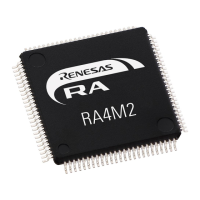Renesas RA Family RA4 Quick Design Guide
R01AN5988EU0100 Rev.1.00 Page 48 of 51
Jul.21.21
15. General Layout Practices
15.1 Digital Domain vs. Analog Domain
Renesas RA4 Microcontroller devices have three primary types of pin functions: Power, Digital, and Analog.
Generally, power pins are dedicated for voltage and reference input and do not have multiple functions.
Power pins are typically dedicated to specific portions, or domains, within the MCU. For example, the main
supply voltage for the MCU will provide power to the digital core, many of the digital peripheral functions and
many of the digital I/O pins. The digital domain can be defined as the digital circuitry, digital I/O pins, and the
related power pins. Power pins which are designated for analog functions (such as AVCC0 and the
associated AVSS0) supply specific analog circuitry within the MCU, which is separate from the digital domain
circuitry. The analog domain can be defined as the analog circuitry, analog I/O pins, and the related power
pins.
Digital signals are typically repetitive, switched patterns that are associated with periodic clocks. The
transitions on digital signals tend to be relatively sharp edges, with stable levels of high or low between the
transitions. Each signal must be stable at an acceptable voltage level, referred to as a logic state, within a
specified timeframe. The state of the signal is typically sampled at predetermined clock intervals, using the
edge transition of a clock to evaluate the associated data signals. Small variations in the voltage level of
digital signals are typically acceptable, as long as the level remains within a specified range. However, large
external influences on digital signals can have an acute influence on a digital signal, which can result in an
incorrect logic state at the moment when the data is sampled.
Analog signals are usually quite different. Analog signals may be periodic, but the evaluation of an analog
signal is typically a measurement of voltage over a range instead of logic state. The voltage level of an
analog signal is sampled based on a specific trigger event, and the resulting measurement is processed
using the analog circuitry in the MCU. The accuracy of an analog measurement is directly related to the
accuracy of the sampled voltage level. Any unwanted external influence which may change the voltage level
of an analog input signal, even slightly, can influence the accuracy of the measurement.
Due to the highly multiplexed nature of the I/O pins on Renesas RA4 MCU devices, many I/O pins can be
used for either Analog or Digital functions. This can result in situations where digital and analog functions
may overlap and result in data errors.
To minimize potential problems between digital and analog signal domains, consider the following guidelines.
• When assigning I/O pin functions, select pin functions such that analog pins and digital pins are physically
separated as much as possible.
• Each analog signal should be separated from all other signals as much as possible.
• PCB routing should isolate each analog signal as much as possible. Avoid routing any other signals,
either analog or digital, in the same area.
• Ensure that analog supply voltages and analog reference voltages include appropriate AC filters. This
may be in the form of recommended capacitors located near the MCU voltage pin, or appropriate
inductive filters. The goal is to provide voltage supply and reference voltage with little or no voltage ripple.
• When using dedicated power layers in a PCB design, avoid routing digital signals in the areas of analog
voltages, and avoid routing analog signals in the areas of digital voltages.
For highly sensitive applications, it is highly recommended to evaluate the specific design using simulation
tools to understand the effect that circuit design has on the performance. For example, this may include
applications such as precision sensor designs, or very high-speed digital bus interfaces. Refer to the
“Electrical Characteristics” chapter in the Hardware User’s Manual for the specific requirements for each
peripheral function.
15.2 High Speed Signal Design Considerations
As clock speeds for digital signals increase, the influence of external stimuli on those signals can become
more significant. Some peripheral functions can be classified as "High Speed" digital signals. Additional
design considerations should be made for high speed digital signals.
Crosstalk is a condition where transitions on one signal have an inductive influence on another nearby
signal. When this crosstalk effect is strong enough, the first signal may cause errors on the second signal. To
reduce the effects of crosstalk, use the following general PCB routing guidelines.

